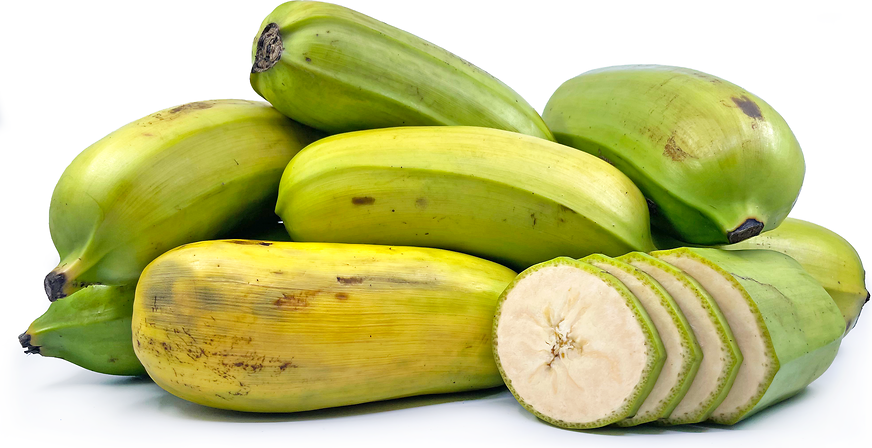


Hopa Bananas
Estimated Inventory, lb : 0
This item was last sold on : 04/23/24
Description/Taste
Hopa bananas widely vary in size and shape, depending on the specific variety, and generally have a bulbous, cylindrical shape with squared, blunt, and curved ends. The fruits range from elongated to squat, and the semi-thick peels are smooth, waxy, and rounded, with a few angular ridges extending the length of the fruit. Hopa bananas are edible in both their green and yellow stages, and in the center of the flesh, there is a line of black seeds. Green Hopa bananas have a firm, somewhat starchy texture that must be cooked to develop a subtly sweet, mild flavor with a creamy, dense consistency reminiscent of a potato. As the fruit ripens, the peel transforms into a golden yellow hue and displays dark brown spots, a signal that the pulp can be eaten fresh. Yellow or mature Hopa bananas convert starches into sugar, creating a soft and tender pulp with a sweet, neutral flavor.
Seasons/Availability
Hopa bananas are available year-round in tropical to subtropical climates.
Current Facts
Hopa bananas, botanically classified as Musa acuminata × balbisiana, are hybrid bananas belonging to the Musaceae family. The name Hopa is a general descriptor used for over 15 different AAB banana cultivars that are a part of the Maoli and Popo’ulu subgroups. Both subgroups are native to Southeast Asia and were spread across Oceania, specifically into Polynesia, where indigenous peoples have cultivated them since ancient times. Hopa bananas are unique, dual-purpose fruits as they display qualities of both fresh eating and cooking bananas. The bananas can be utilized similarly to plantains when they are young and green, or they can be left to ripen and consumed straight, out-of-hand. In the modern-day, Hopa bananas are primarily found on the island of Tonga are rarely seen outside of home gardens and local markets in Polynesia.
Nutritional Value
Hopa bananas are a good source of dietary fiber to regulate the digestive tract. The bananas also contain potassium to balance fluid levels in the body, vitamin C to strengthen the immune system, vitamin A to maintain healthy organ functioning, and lower amounts of iron, vitamin K, magnesium, vitamin B6, and folate.
Applications
Hopa bananas are traditionally used in their green stage as the fruits are just beginning to ripen. When green, the bananas contain a starchy consistency that is best suited for cooked applications, prepared similarly to common plantains. The fruits can be boiled or baked with the skin on or off, and once cooked, the peel is removed, and the pulp is consumed whole, sliced, or mashed. Hopa bananas can also be peeled, sliced, and fried as a breakfast dish, boiled and combined with aromatics, spices, and lime juice as a fresh salad, mashed and fried into pancakes, or cooked, rolled into balls, and fried into fritters. The starchy, green bananas serve as a substitute for potatoes or other root vegetables and are often served as a side dish to fish, soups, and curries. In addition to cooking, Hopa bananas can also be left to fully ripen, the peel turning yellow, and treated similarly to dessert bananas. The pulp can be sliced and tossed into fruit salads, blended into smoothies and other beverages, layered over toast, or baked into banana bread, muffins, and cakes. Hopa bananas pair well with coconut cream, chile peppers, citrus, taro or cassava, poultry, and fresh herbs and spices like coriander, pele or Togan spinach, and turmeric. Green, raw Hopa bananas can be kept at room temperature and used within a few days for cooked preparations. The bananas can also be stored at room temperature for up to one week to fully ripen for fresh consumption.
Ethnic/Cultural Info
In Tonga, Hopa bananas are an everyday, staple ingredient prepared as a filling side dish. Green cooking bananas are a valuable source of carbohydrates for Tongan residents, and Hopa bananas are most notably served alongside ota’ika, Tonga’s national dish. Ota’ika is comprised of freshly caught, raw fish and is steeped in coconut milk seasoned with green peppers, onions, spices, and tomatoes. The national dish is traditionally served with heavier accompaniments such as green bananas, sweet potatoes, or taro to create a balanced, filling meal. Hopa bananas have also become a part of other island cuisines. In Tahiti, overly ripe Hopa bananas are made into po’e, a type of thick and sweetened banana pudding made with arrowroot starch and covered in coconut cream. Customarily, the pudding was wrapped in banana leaves and cooked in an earthen oven, or umu.
Geography/History
Bananas are native to Southeast Asia and were spread into Oceania through ancient indigenous peoples. Over time, many new hybrids of bananas arose from extensive cultivation, and Hopa bananas were developed from banana varieties brought to the Polynesian country of Tonga, which is comprised of 169 islands, 36 of which are inhabited. From Tonga, Hopa bananas spread to other islands, including Samoa, Tahiti, the Cook Islands, and Fiji. A population of Tongans also moved to Hawaii, bringing Hopa bananas, and the fruits can be still be found growing in limited quantities on several of the islands. Today Hopa bananas can be found in tropical to subtropical regions worldwide, mainly in Polynesia, and are also grown as an exotic home garden cultivar among banana enthusiasts.
Recipe Ideas
Recipes that include Hopa Bananas. One
Podcast

















